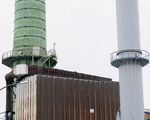15.7.- 31.10.2022 DER ÖKOLOGISCHE FUSSABDRUCK DER BILDPRODUKTION
←
→
Transkription von Seiteninhalten
Wenn Ihr Browser die Seite nicht korrekt rendert, bitte, lesen Sie den Inhalt der Seite unten
ERÖFFNUNG
DONNERSTAG
14. JULI 2022
19 UHR
OPENING
THURSDAY
14 JULY 2022
7 PM
Museum für Kunst
& Gewerbe Hamburg
Steintorplatz
20099 Hamburg
www.mgk-hamburg.deMINING PH OTOGRAPHY Eröffnung | Opening Donnerstag, 14. Juli 2022, 19 Uhr Thursday, 14 July 2022, 7 pm Begrüßung | Welcome Prof. Tulga Beyerle, Direktorin | Director Boaz Levin & Dr. Esther Ruelfs, Kurator*innen | Curators Kostenlose Eröffnungs-Tickets Free Opening-Tickets tickets.mkg-hamburg.de Führung | Tour Freitag, 15. Juli 2022, 15 Uhr Friday, 15 July 2022, 3 pm Mit den Künstler*innen | With the artists Ignacio Acosta, F & D Cartier, Susanne Kriemann, Lisa Rave, Tobias Zielony Alternative Hafenrundfahrt | Alternative harbor boat tour Samstag, 16. Juli 2022, 13.45 Uhr Saturday, 16 July 2022, 1.45 pm Mit dem Künstler | with the artist Ignacio Acosta & Klaus Baumgardt (Förderkreis „Rettet die Elbe“) Infos: mkg-hamburg.de/veranstaltungen Künster*innen | Artists Ignacio Acosta, Lisa Barnard, F & D Cartier, Klasse Digitale Grafik HFBK Hamburg (Mari Lebanidze, Cleo Miao, Leon Schwer und Marco Wesche), Susanne Kriemann, Mary Mattingly, Daphné Nan Le Sergent, Optics Division of the Metabolic Studio (Lauren Bon, Tristan Duke, Richard Nielsen), Lisa Rave, Alison Rossiter, Robert Smithson, Simon Starling, Anaïs Tondeur, James Welling, Noa Yafe, Tobias Zielony
S eit ihrer Erfindung ist die Fotografie von der Gewinnung und der Ausbeutung natür- licher Rohstoffe abhängig. Im 19. Jahrhundert waren es Salz, Kupfer und Silber, die für die ersten Fotografien auf Kupferplatten und für Salzpapierabzüge genutzt wurden. Mit dem Aufkommen der Silbergelatineabzüge im späten 20. Jahrhundert wurde die Fotoindustrie mit etwa einem Viertel des weltweiten Ver- brauchs zur wichtigsten Abnehmerin für Silber. Im Zeitalter der digitalen Fotografie und der Smartphones ist die Bildproduktion auf seltene Erden und Metalle wie Koltan, Kobalt und Europium angewiesen. Die Speicherung der Bilder und ihre Distribution produzieren zudem großen Mengen an CO2. Die Ausstellung wid- met sich der Materialgeschichte zentraler Roh- stoffe der Fotografie und stellt den Zusam- menhang zur Geschichte ihres Abbaus, ihrer Entsorgung und dem Klimawandel her. Abbildungen vorne | Images front: John Cooper, Minenarbeiterin, 1860er Jahre, © Trinity College Library, Cambridge / Anaïs Tondeur, Carbon Black, 2017 / Tetraedrit mit Silberanteilen, Sammlung Alexander von Humboldt, Museum für Naturkunde Berlin / Optics Division of the Metabolic Studio (Lauren Bon, Tristan Duke, and Richard Nielsen), Liminal Prints Buried in Owens Lake, 2016 / Tobias Zielony, Dunkelraum, 2022 / Robert Smithson, Asphalt Rundown, 1969, Rome, Italy, Foto: Robert Smithson, © Holt/Smithson Foundation / VG Bild-Kunst, Bonn 2022 Hinten | back: Tobias Zielony, Dunkelraum, 2022 / Silberbarren im Tresor von Kodak, 1945, Kodak Historical Collection, University of Rochester, Nutzung erlaubt durch Eastman Kodak Company / John Cooper, Minenarbeiterin, 1860er Jahre, © Trinity College Library, Cambridge / Ignacio Acosta, Hygieia Watches Over Us, 2022 / Lisa Barnard, Broken mobile phone screen, Shenzhen, China, 2018 / Optics Division of the Metabolic Studio (Lauren Bon, Tristan Duke, and Richard Nielsen), Owens Lake Panorama 1 (Lakebed Developed), 2013 / Anaïs Tondeur, Carbon Black, 2017 Klappe | flap: Hermann Reichling, Kraftwerk, 1938, © LWL-Medienzentrum für Westfalen / Lisa Rave, Europium, 2014 / Susanne Kriemann, Restpflanzen, 2017–2020 / Ignacio Acosta, Hygieia Watches Over Us, 2022 © Künstler*innen und Fotograf*innen
E ver since its invention, photography
has depended on the global extraction and ex-
ploitation of natural resources. In the early
19th century, these were salt, copper and silver,
which were all used for the first images on
copper plates and for salt paper prints. By the
late 20th century, the photographic industry
was one of the most important consumers
of silver, responsible, at its peak, for about a
quarter of the metal’s global consumption.
Today, with the advent of digital photography
and the ubiquity of mobile devices, image
production is contingent on rare earths and
metals such as coltan, cobalt, and europium.
Image storage and distribution also consume
immense amounts of energy. The exhibition
is dedicated to the material history of key
resources used for image production, adress-
ing the social and political context of their
extraction and waste and its relation to climate
change.
In Kooperation mit | in cooperation with
Kunst Haus Wien und
Gewerbemuseum Winterthur
Mit freundlicher Unterstützung von | Supported by
Design: Studio PandanSie können auch lesen



























































